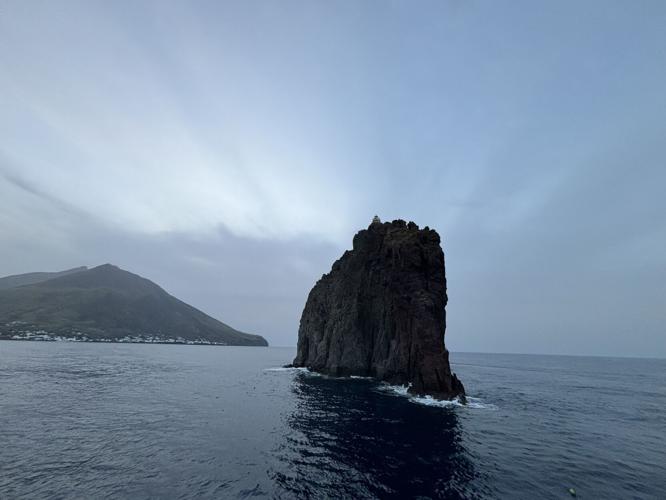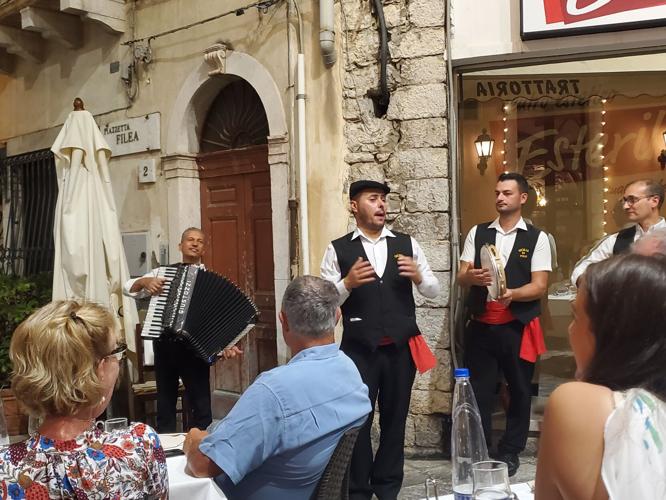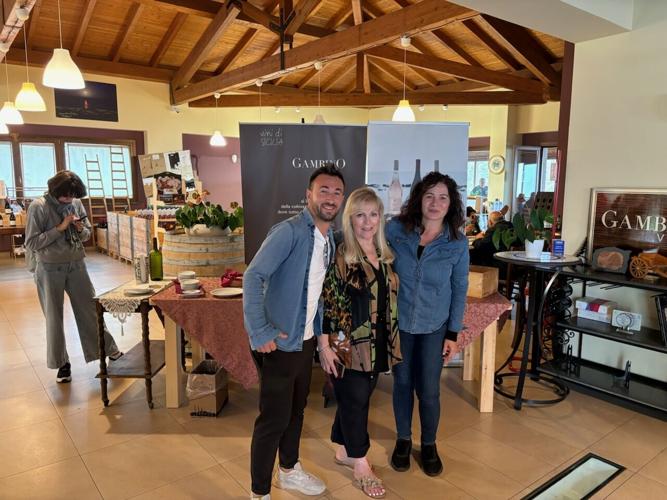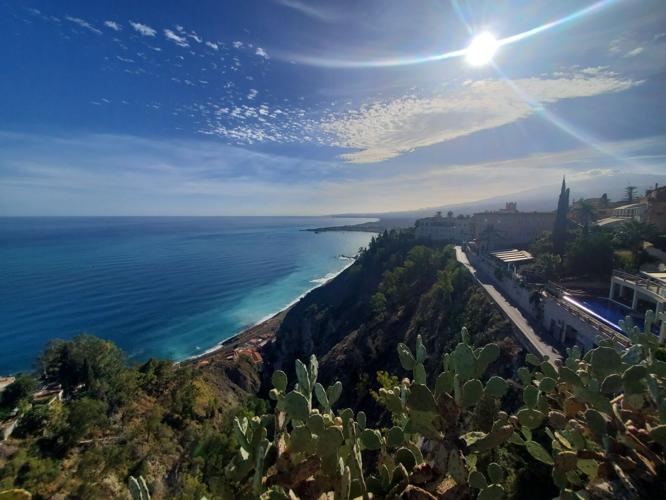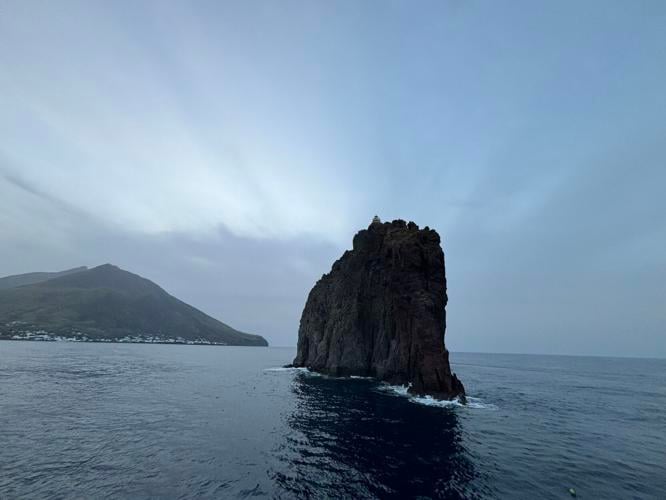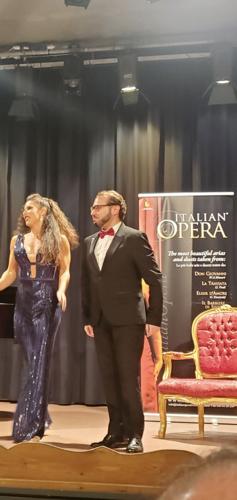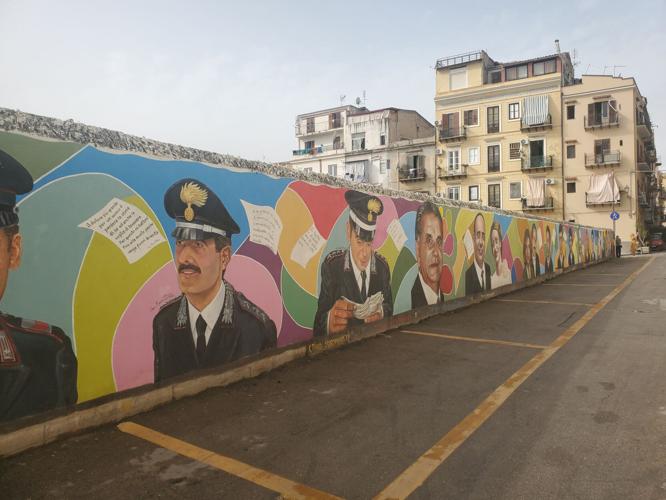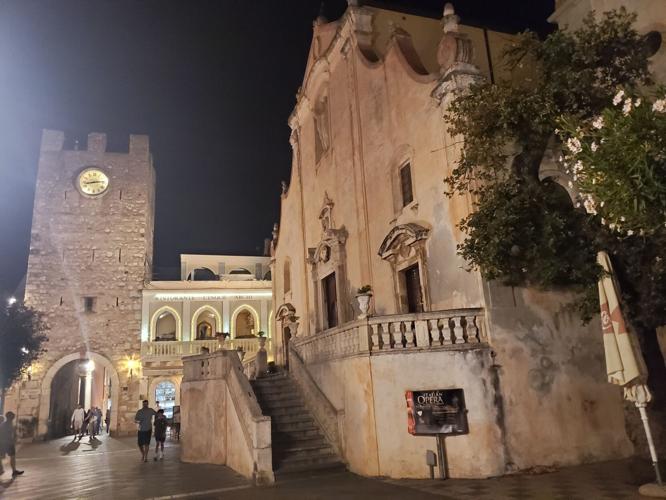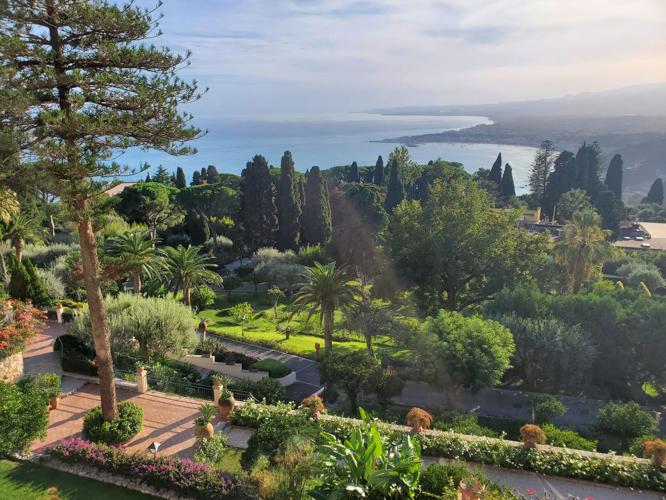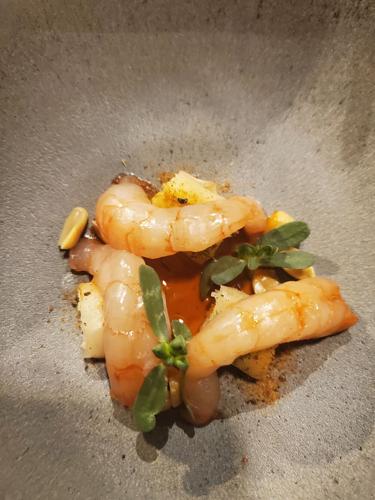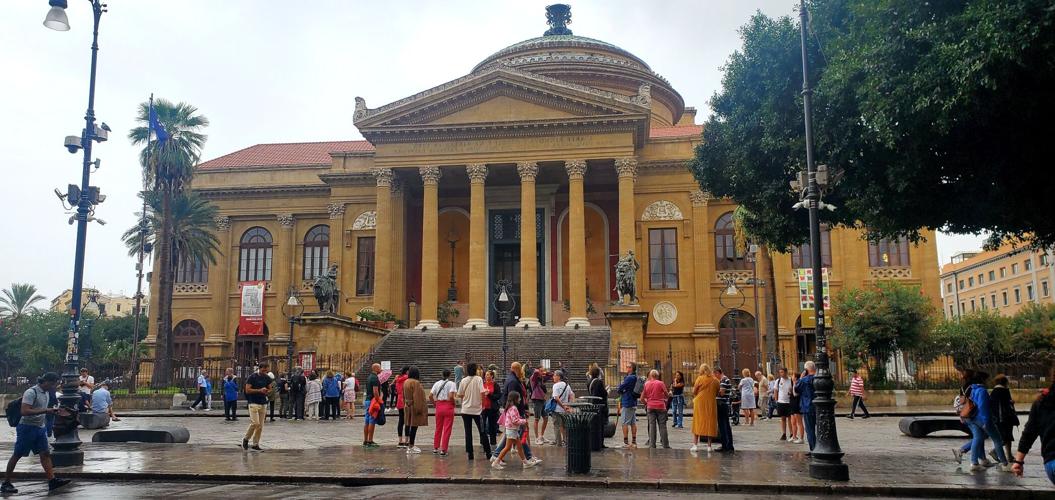If Season 2 of the hit HBO series, “The White Lotus,” has piqued your interest about the Taormina area of Sicily and the Italian island in general, you’re not alone. Hoteliers in Taormina, which lies off the toe of Italy’s boot, have seen a fourfold increase in tourism just in the last year. That includes the Four Seasons Hotel, where the popular series is shot.
If you’ve thought about journeying to this part of the world, which Sigmund Freud called the loveliest part of Italy, this might be the time to pack your bags.

The Taormina coastline displays its ever-present hillside prickly pear cactus, brought to the island by the Spaniards in the 15th century.
During the offseason between November and February, hotel rooms are decidedly less expensive, as is airfare. (Yet, the temperatures in winter are a pleasant 50-60 degrees F.)
There are no direct flights from New Orleans to either one of the Sicilian airports — in the capital city of Palermo or the eastern city of Catania — so connect through Rome for the hourlong hop to either airport within Sicily.
The New Orleans connection

Starting in 1884 and continuing through to 1924, an estimated 290,000 Italian immigrants, a great deal of them from Sicily — arrived in New Orleans, fleeing economic and political turmoil.
New Orleans has a storied connection to the Italian island of Sicily. Between 1884 and 1924, nearly 300,000 Italian immigrants, most of them Sicilian, moved to New Orleans, earning the French Quarter the nickname “Little Palermo.” Their descendants today make up a sizable population across the metro area, and their impact is still felt in the area's food, music and religious celebrations.
Originally, Sicilians were not welcomed by New Orleans residents, who thought their different language and customs made them dangerous. Some even assumed they were associated with the Mafia. Many of these immigrants were actually fleeing from organized crime and corruption in their homeland.
Sicilian descendants have made their mark in America: Frank Sinatra, Joe DiMaggio, Lady Gaga, Jon Bon Jovi and Al Pacino, just to name a few. And New Orleans has had Louis Prima and multiple jazz legends.
Palermo's melting pot
Heading out in mid-October, we chose Palermo as our gateway, because the city is steeped in culture that is unlike other mainland Italian cities.

Avocado pesto soup at the Michelin restaurant Gagini in Palermo.
From its food to its architecture, which reflects its prior occupation by Arabs, Greeks, Normans and Swedes, it is truly a unique melting pot of civilizations.
In the 1600s, the Moors brought their fruit juice and ice concoctions, which were perfected by the Sicilians into what we now know as gelato — in New Orleans and the world over.
Palermo’s pastas are unique, often served with lemon pesto, sardines, native mushrooms, pine nuts, pistachios and a variety of Italian cheeses.

Teatro Massimo in Palermo.
Food aside, there is the magnificent Teatro Massimo, the largest opera house in Italy, and one of the largest in all of Europe. It is known for its perfect acoustics.
A Mafia history
But Palermo is also the place where La Cosa Nostra, aka the Mafia, originated. In its grip from the early 1800s, Palermitani citizens had accepted for centuries that protection money to the Mafia dons was part of the cost of doing business.

A wall in Palermo is devoted to judges and members of the police force who were assassinated by the mafia at the height of its power.
In 1971, when Francis Ford Coppola brought his cast and crew to Palermo to film the Sicilian scenes in “The Godfather,” he himself ran into the Mafia, which demanded protection money for each day of shooting.
Coppola quickly moved the shoot to the Taormina area in the Messina province of Sicily, and shot there without incident.
Finally, in 2004, five brave students formed a group called Addiopizzo, or goodbye to "pizzo" — the Italian word for Mafia extortion money.
The students were just children in the 1990s, when the Mafia-fighting Judge Giovanni Falcone was bombed into oblivion on a Sicilian motorway, along with his magistrate wife and three bodyguards. The students enlisted 100 defiant shopkeepers, who posted signs in their windows that said they would no longer pay the Mafia.
The movement quickly spread across Palermo and Catania, Sicily’s second-largest city, until 9,000 businesses were standing up to the crime syndicate.
Shopkeepers who continued to pay were listed in a book that asked tourists not to frequent their stores. Twenty years later, protection money is a thing of the past.
At its height, however, 200 million euros ($217 million) were being extorted yearly from the Sicilian economy, and hundreds of judges and countless Italian police officers were assassinated.
The “No Mafia Tour,” in Palermo, guided by members of Addiopizzo, is a fascinating walking tour that defines the struggles involved in battling organized crime.
Scenic Taormina
Drive 2½ hours east on the Autostrada, where speed limits are already high, but most cars are still whizzing along at 140 kilometers per hour (87 mph), and bask in the amazing scenery of Taormina.
Nestled on the northeastern coast, it has spectacular views of Mount Etna, the Aeolian islands, and Isola Bella, the closest island to Sicily, connected by a narrow footpath from the mainland beach in Taormina.
Take a funicular rail car to the top of 11,000-foot-high Mount Etna, the tallest active volcano in Europe, which last erupted in February 2021.

The author, center, meets new friends at a winery on Mount Etna.
Although the town below incurred significant damage, the surrounding black volcanic ash provides the slopes with a rich mineral base for the many vineyards surrounding the mountaintop.
This region was flung into the international spotlight 15 years ago for its distinctive, award-winning wines. We shipped two cases back to New Orleans.
Views from a boat
To see an active volcano, book one of the Aeolian Island tours, which takes visitors to a variety of the seven volcanic islands, hours away by boat. Mount Stromboli, on the island by the same name, erupts every 20 minutes.

Stromboli's volcano blows its top as the sun sets over the Ionian Sea.
Its incandescent volcanic bombs lit up the night sky as our boat pulled away from the harbor, and my 11-year-old boatmate, Espen Goergens, snapped a great photo. This volcano has been erupting continuously now for over 90 years.
The most charming part of Taormina is the hilltop village along Corso Umberto, which stretches for 2 miles.

Sidewalk serenaders stroll the Corso Umberto in Taormina, entertaining diners along the way.
The village is wall-to-wall boutiques and al fresco dining spots, where strolling quartets sing Italian standards.
The walkway is replete with magnificent churches, an opera house, and Piazza del Duomo, the plaza that’s home to the beautiful 197-foot bell tower with the world’s largest astronomical clock, putting on a 12-minute show every day at noon. Mechanical figures strike the bell, roosters crow and lions roar. It’s not to be missed.
Terraced bars and opera

View of the Taormina coastline from the bar of the Grand Timeo Hotel, overlooking the famous gardens of Villa Comunale.
Along the village walkway, you’ll find 5-star hotels that rival any in the world. Even if you don’t stay in them, get a drink in one of their overhanging terraced bars (my favorite is the Grand Timeo Hotel) which sit above the famous Villa Comunale Gardens. You’ll swear you’re looking at a picture postcard — it doesn’t look real!
Next door you’ll come upon what looks like a smaller version of the Coliseum in Rome. The Teatro Antico, a Greco-Roman amphitheater which dates back to the third century B.C. is still used for stage plays.
In between performances, you can walk the grounds and have lunch with an amazing view of snow-capped Mount Etna and the Ionian Sea, below.

One of countless rock formations in the Ionian Sea, which contain cavern-like grottos that small boats wind through.
Whether you love opera or know nothing about it, look into Teatro Nazarena, which performs opera from May through October. Various artists perform the most beautiful arias and duets from the likes of "Don Giovanni," "La Traviata," "Madame Butterfly" and so much more. It’s akin to opera’s greatest hits. Book early as every performance sells out.
If you wish to hit all the high points of Sicily, you’ll need 10 days to traverse the island by car. Or pick a few spots that you’re most interested in and map out your own personally cultivated road trip.
Leslie Cardé can be reached at lesliecardejournalist@gmail.com.


